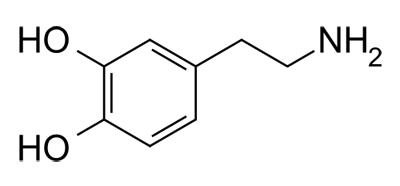Novelty seeking is a personality trait of people who tend to be very interested in new activities and novel stimulations, are quite impulsive in their decisions, and quickly lose their temper. It is measured in the Temperament and Character Inventory and is considered one of the temperament dimensions of personality. Like the other temperament dimensions, it has been found to be highly heritable.

In the TCI novelty seeking consists of the following four points:
• Exploratory excitability
• Impulsiveness
• Extravagance
• Disorderliness
Novelty seeking is positively related to impulsive sensation seeking and a high novelty seeking trait has been suggested to be related to high dopaminergic activity.
DOPAMINE:

Dopamine, a metabolite of the amino acid tyrosine, is a catecholaminergic neurotransmitter that exerts its actions on neuronal circuitry via a relatively slow modulation of the fast neurotransmission that is mediated by glutamate and GABA. Four major dopaminergic pathways have been identified in the mammalian brain:
• the nigrostriatal system
• the mesolimbic system
• the mesocortical system
• the tuberoinfundibular system
These neurons are involved in vital central nervous system functions, such as: voluntary movement, feeding, affect, reward, sleep, attention, working memory and learning.
The dopaminergic neurons involved in novelty seeking trait are those located in the midbrain. Midbrain dopamine neurons are positioned within three cell groups: Ventral Tegmental Area (VTA), Substantia Nigra compacta (SNc), and Retrorubral Area. There is no clear anatomical distinction or boundaries between the groups.
DOPAMINE RECEPTORS:
Once released from presynaptic terminals, dopamine activates members of a family of G protein-coupled dopamine receptors named D1 to D5. Targeting these receptors using specific agonists and antagonists has provided an opportunity to significantly influence dopaminergic transmission and dopamine-dependent functions by enhancing or blocking the actions of dopamine. Hundreds of pharmacologically active compounds that interfere with dopamine receptor functions at the level of ligand binding have been developed, and many of these compounds have been used for clinical applications in the treatment of various disorders.
Here we analyze the D2-class dopamine receptors, because it is the class involved in the novelty seeking trait. The D2-class dopamine receptors ( D2, D3, and D4) couple to the Gi family of G proteins. When dopamine targets D2 receptors, it can signal through different pathways:
1. Gαs : inhibition of adenylate cyclase and reduction of cAMP and PKA activation.
2. Regulation of Gβγ signaling: Gβγ stimulates PLC, that regulate the intracellular calcium level.
In contrast to the D1-class dopamine receptors, D2 and D3 dopamine receptors are expressed both postsynaptically on dopamine target cells and presynaptically on dopaminergic neurons.
The highest levels of D2 dopamine receptors are found in the striatum, the nucleus accumbens, and the olfactory tubercle. D2 receptors are also expressed at significant levels in the substantia nigra, ventral tegmental area, hypothalamus, cortical areas, septum, amygdala, and hippocampus.
Presynaptically localized autoreceptors generally provide an important negative feedback mechanism that adjusts neuronal firing rate, synthesis, and release of the neurotransmitter in response to changes in extracellular neurotransmitter levels. Activation of presynaptic D2-class autoreceptors generally causes a decrease in dopamine release.
ROLE OF D2 RECEPTORS IN NOVELTY SEEKING:
Rodent models of temperament indicate that high novelty responding is associated with decreased autoreceptor control of midbrain dopamine. More recent studies have been performed on humans and they revealed a significant inverse association between Total Novelty-Seeking Scores (tested with the Novelty Seeking Scale of the Tridimensional Personality Questionnaire) and presence of D2 autoreceptors in the dopamine midbrain bilaterally, particularly in Ventral Tegmental Area and in Substantia Nigra. Both dopamine receptor levels and novelty-seeking traits decline with age.
So these results suggest a specific inverse relationship between novelty seeking traits and autoreceptor availability. Because the dopamine autoreceptor is a potent regulator of the ability of dopamine cells to fire, individual differences in this autoinhibitory control mechanism would be expected to lead to substantial differences in the impulse properties of dopamine neurons, and hence dopamine release.
The specific role of D2 autoreceptor regulation in influencing novelty-seeking behavior likely reflects the privileged ability of novel stimuli to trigger SN/VTA firing. Three recent Magnetic Resonance Imaging studies observed blood oxygen level-dependent (BOLD) responses in the SN/VTA region when healthy humans viewed novel pictures or associations. Presumably this reflects a burst of dopamine cell firing in response to novelty, that provides a motivating “exploration bonus”, encouraging exploration of stimuli or environments. These studies revealed that individuals with lower autoreceptor levels seem to have a greater “exploration bonus” than those with higher autoreceptor levels.
Given the previous data on novelty seeking and dopamine autoregulation, it follows that high novelty seekers will have enhanced striatal responses during conditions that release dopamine.
In fact they have got a lower number of available D2 autoreceptors located presinaptically in the midbrain, so local somatodendritic release of dopamine produces less autoinhibition of dopamine cell firing, because there are little available autoreceptors and it is unlikely that dopamine targets them.

As a consequence, high novelty seekers release more dopamine in axon target regions, when stimulated by novelty or other conditions, that cause midbrain dopamine cells to fire.
So novelty seeking traits are determined by the major or minor presence of these D2 autoreceptors and as a consequence by dopamine firing. This personality traits are also a major risk factor for the development of drug abuse and other unsafe behaviours.
REFERENCES:
- http://en.wikipedia.org/wiki/Novelty_seeking
- http://www.scholarpedia.org/article/Models_of_midbrain_dopaminergic_neurons
- The Physiology, Signaling, and Pharmacology of Dopamine Receptors (Jean-Martin Beaulieu and Raul R. Gainetdinov)
- Midbrain Dopamine Receptor Availability Is Inversely Associated with Novelty-Seeking Traits in Humans (David H. Zald, Ronald L. Cowan, Patrizia Riccardi, Ronald M. Baldwin, M. Sib Ansari, Rui Li, Evan S. Shelby, Clarence E. Smith, Maureen McHugo, and Robert M. Kessler); The Journal of Neuroscience, December 31,2008